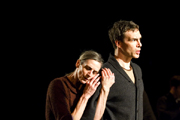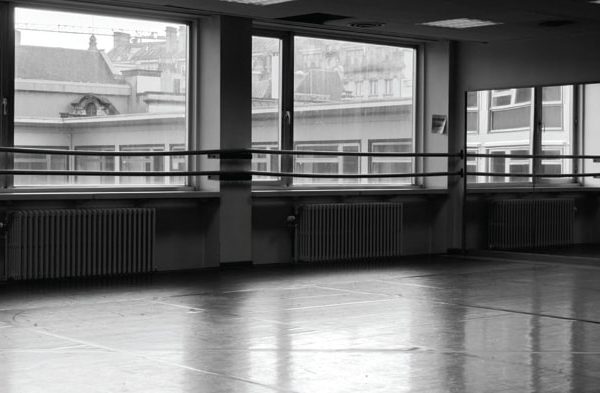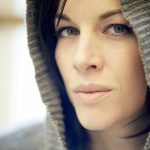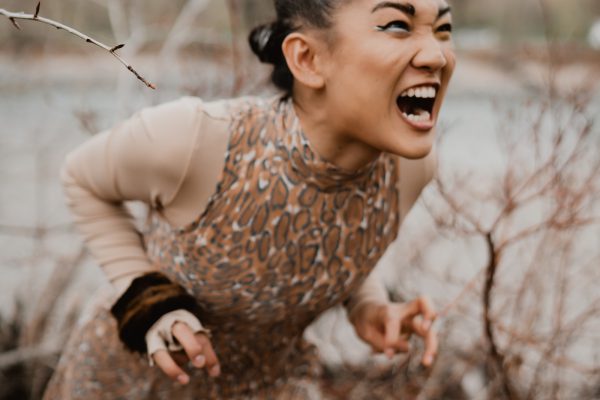If you like your dance presented in a mixed media production, then Sophie’s Corriveau’s Jusqu’au silence is just for you. Interspersed with the live dance are drawings and video projections (courtesy of her immensely talented brother Thomas Corriveau). Produced by Danse-Cité in its “Traces-interprètes” series, and performed at the Agora de la danse, this show gave Corriveau the chance to launch in new directions, not simply as a performer but as a choreographer, and the opportunity to guide her own production from the ground up. Over the last twenty-five years, Corriveau has been a familiar figure on this city’s stages, dancing for many choreographers, from James Kudelka to Jean-Pierre Perreault and Sylvain Émard.
The concept for this imaginative, oneiric performance developed from the idea of re-entering some of the feelings and sensation experienced when her mother died while Corriveau was still in her teens. The mother was, apparently, quite a writer, logging in great detail a myriad of family reminiscences in journal-scrapbooks chock-a-block with words, sketches and photos. It is these images and thoughts that Corriveau used in the studio to dive into improvisations and movement invention.
In truth, what excites, right from the start, is the set. Normally at the Agora, the rake of the seats provides for an often-distant experience of the performance. Here, the stage is elevated, enabling the audience to see Corriveau in a much more direct and intimate manner. A large screen, covering the back wall, is behind her.
While the audience enters and gets seated, Corriveau seems in reverie, certainly not acknowledging its presence. Little twitches of the head indicate that she’s in a world of her own. She’s wearing a blue anorak, with a hood covering her head, plus she’s got an apron tied around her waist, a black skirt, leggings and shoes. And she’s growling. Placed around the stage are four white boxes, a ladder and a metal trashcan. Often she seems to be enacting some child-like horror-fairytale. With her brow furrowed, and her face shrouded by that hood, Corriveau picks up a mallet with a long handle, and seems determined to smash an onion to smithereens. It’s a menacing, crazed moment. She eventually drops that implement, only to pick up a knife, and proceeds to carve the onion, jabbing it, hacking away at it, and smelling its core. Rousing as if from her demented state, she looks up suddenly, almost aware that she is being looked at, caught in the moment. She scoops up the wedges, and then she spreads the pieces across the floor, beyond the stage. She wipes her eyes with the apron.
With this role, it’s not what Corriveau does, but what she implies that gives life to her tableaux. Somewhere mid-way into the piece, she speaks in a high-pitched child-like voice, in English, “Once upon a time …” and starts off reciting a fable, in which she proceeds to tell the tale of a young girl whose mother dies too young. The young girl, as she tells it, has “happy times”, and then finds herself in “black holes”. Eventually she removes an outer layer to reveal a tight-fitting sports top. She then takes a pose, balances and then falls off-balance. Her ankles buckle, her arms go wide, and she kicks a leg up and out. She jumps forward, once, twice, three, and four times, until she reaches the outer edge of the stage. This bit of uncomplicated choreography repeats itself a few more times in the piece. She rotates her arms, fast then faster, first the left side, then the right, as if she’s a wind-up toy. There is more dressing and undressing — essentially she plays masquerade. She violently punches the side of one of the white boxes, pulling out other bits of clothing, and layers up again (in one sequence she appears to be almost full-term pregnant). The manic, almost obsessive, need to layer the body, or fixatedly keep it hidden, seems reflective of a shifting psychological state or temperament. It’s also suggestive of a private indulgence as opposed to a behaviour that’s negotiated in a wider world.
One of the achievements of the piece, and a prominent and exhilarating part of Jusqu’au silence, is the gallery of media images, drawn by Corriveau’s brother, Thomas. Corriveau frère’s video elements perfectly fuse into the larger body of the work. The brother photographed his sister, then created line drawings that render her life-like essence, and which read perfectly from afar. These visuals anchor her in some sort of graspable reality. What he’s mastered next in the editing suite is surprising and captivating, managing to layer her various images digitally, creating abstraction upon abstraction, a riotous mash-up that further drives the syncopation of the piece. In those first animations, his hand-drawn “Sophie” recreates the hopping and skipping we’ve seen live just moments before. The images of Corriveau, in those simple animated line drawings, multiply: on the floor of the stage, on the wall screen, plus on the little white boxes on the stage. A vibrant spectrum of colours emerges too, first suggested by a colour-bar motif that creeps across the screen. These details give another shot of potency to the production.
Jusqu’au silence is challenging and uplifting in its skilled approach to production. Marc Parent’s subtle lighting captures Corriveau’s riveting solitude, shifting warmer and cooler tones, and working with shadows and illumination. He’s enhancing what the dancer embodies so effortlessly: at times who this creature is feels fragile and wrought with deep-set emotion; at others, she’s merely adrift. And the music by Michel F. Côté is a counterpoint collage of possibilities, moving from pensive, romantic solo piano to aggressive industrial sounds, and pure distortion, evoking the refusal to admit to certain emotions.
Intimacy, or the lack of it, is fertile ground for the imagination in Corriveau’s universe. She invokes the loss of love or affection through actions and choices, such as the wearing of the apron in the cleaving of the onion, or the cocooning that’s achieved through the layering of the clothing (or is it mummification?).
In the final moments, the back screen fills with a moving animation sequence, in which we see a route weaving along through a thicket of trees and forest; slowly but surely a path opens up and the scene shifts into an open landscape, dotted here and there by homes. We feel the expanse, and the possibility of what lies ahead on this long and winding road. This is an adult work — that is partly its strength and, from an audience’s perspective, its great pleasure.
Tagged: Contemporary, Interdisciplinary, Performance, Montréal , QC





